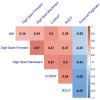Comparison of Neurocognitive Functioning and Fine Motor Skills in Pediatric Cancer Survivors and Healthy Children
- PMID: 36497461
- PMCID: PMC9738267
- DOI: 10.3390/cancers14235982
Comparison of Neurocognitive Functioning and Fine Motor Skills in Pediatric Cancer Survivors and Healthy Children
Abstract
Background: The late treatment outcomes of pediatric brain tumors and of hematopoietic and lymphoid tissue tumors are an important focus of both rehabilitation and research. Neurocognitive and motor disorders induce further learning problems impeding social-emotional adaptation throughout a whole lifespan. Core deficits in short-term and working memory, visuospatial constructional ability, verbal fluency, and fine motor skills underlie distorted intellectual and academic achievement. This study aimed to assess the individual differences in cognitive ability and fine motor skills of pediatric tumor survivors and the age-matched healthy controls. Methods: A total of 504 tumor survivors after treatment and 646 age-matched healthy controls underwent neurocognitive and fine motor assessments. Findings: The group of tumor survivors scored significantly worse in both neurocognitive and fine motor skill in compared with the healthy control group. The pediatric brain tumor survivors (PBT group) performed worse in cognitive (p < 0.001 for verbal fluency and p < 0.001 for visuospatial constructional ability) and motor tests (p < 0.001) compared to the healthy controls. Hematopoietic and Lymphoid Tissues tumors survivors (THL group) performed worse in verbal fluency (p < 0.01) and visuospatial constructional test (p < 0.001) compared to the control group. Furthermore, the PBT group had worse results in visuospatial constructional ability (p < 0.05) and fine motor (p < 0.001) ability than the THL group. Significant differences between females and males were found in fine motor test performance in the PBT group (p < 0.05), as well as in verbal fluency (p < 0.01) and visuospatial constructional ability (p < 0.01) in the control group. Neurocognitive and fine motor skill characteristics in the THL group did not correlate with age.
Keywords: fine motor skill; neurocognitive functioning; pediatric brain tumor; tumors of hematopoietic and lymphoid tissues.
Conflict of interest statement
The authors declare no conflict of interest.
Figures








Similar articles
-
Motor functioning and associated cognitive outcomes in pediatric survivors of acute lymphoblastic leukemia.Child Neuropsychol. 2020 Jul;26(5):597-611. doi: 10.1080/09297049.2019.1676406. Epub 2019 Oct 9. Child Neuropsychol. 2020. PMID: 31594450
-
Neurocognitive and Psychosocial Outcomes in Pediatric Brain Tumor Survivors.Bioengineering (Basel). 2018 Sep 11;5(3):73. doi: 10.3390/bioengineering5030073. Bioengineering (Basel). 2018. PMID: 30208602 Free PMC article. Review.
-
Progressive declines in neurocognitive function among survivors of hematopoietic stem cell transplantation for pediatric hematologic malignancies.J Pediatr Hematol Oncol. 2008 Jun;30(6):411-8. doi: 10.1097/MPH.0b013e318168e750. J Pediatr Hematol Oncol. 2008. PMID: 18525456
-
Surgically restoring portal blood flow to the liver in children with primary extrahepatic portal vein thrombosis improves fluid neurocognitive ability.Pediatrics. 2006 Mar;117(3):e405-12. doi: 10.1542/peds.2005-1177. Epub 2006 Feb 15. Pediatrics. 2006. PMID: 16481447
-
Meta-analysis of cognitive functioning in breast cancer survivors previously treated with standard-dose chemotherapy.J Clin Oncol. 2012 Oct 10;30(29):3578-87. doi: 10.1200/JCO.2011.39.5640. Epub 2012 Aug 27. J Clin Oncol. 2012. PMID: 22927526 Free PMC article. Review.
Cited by
-
A scoping review evaluating physical and cognitive functional outcomes in cancer survivors treated with chemotherapy: charting progress since the 2018 NCI think tank on cancer and aging phenotypes.J Cancer Surviv. 2024 Aug;18(4):1089-1130. doi: 10.1007/s11764-024-01589-0. Epub 2024 May 14. J Cancer Surviv. 2024. PMID: 38743185 Free PMC article.
-
Effects of cognitive-motor intervention for pediatric posterior fossa tumor survivors: results of a pilot study.J Neurooncol. 2024 May;168(1):57-67. doi: 10.1007/s11060-024-04636-z. Epub 2024 Mar 15. J Neurooncol. 2024. PMID: 38489149
-
Picture naming test through the prism of cognitive neuroscience and linguistics: adapting the test for cerebellar tumor survivors-or pouring new wine in old sacks?Front Psychol. 2024 Mar 19;15:1332391. doi: 10.3389/fpsyg.2024.1332391. eCollection 2024. Front Psychol. 2024. PMID: 38566942 Free PMC article. Review.
-
Disease burden and healthcare utilization in pediatric low-grade glioma: A United States retrospective study of linked claims and electronic health records.Neurooncol Pract. 2024 Apr 27;11(5):583-592. doi: 10.1093/nop/npae037. eCollection 2024 Oct. Neurooncol Pract. 2024. PMID: 39279771 Free PMC article.
References
-
- Kesler S.R., Ogg R., Reddick W.E., Phillips N., Scoggins M., Glass J.O., Cheung Y.T., Pui C.-H., Robison L.L., Hudson M.M., et al. Brain Network Connectivity and Executive Function in Long-Term Survivors of Childhood Acute Lymphoblastic Leukemia. Brain Connect. 2018;8:333–342. doi: 10.1089/brain.2017.0574. - DOI - PMC - PubMed
Grants and funding
LinkOut - more resources
Full Text Sources

